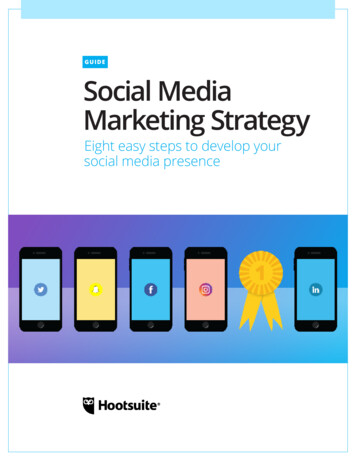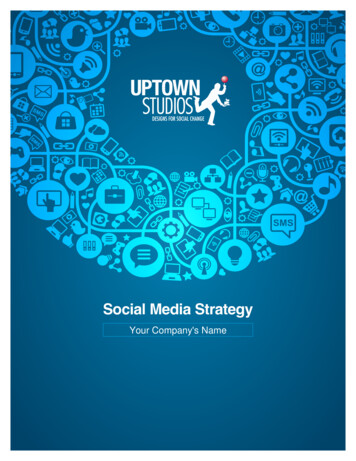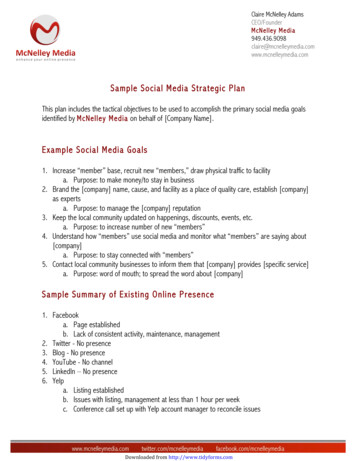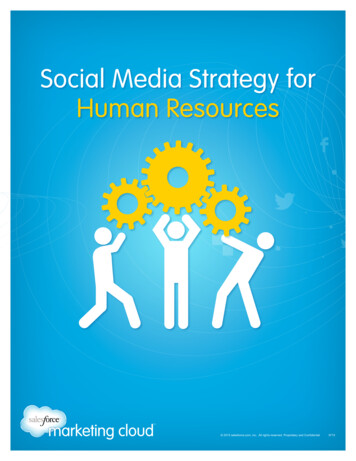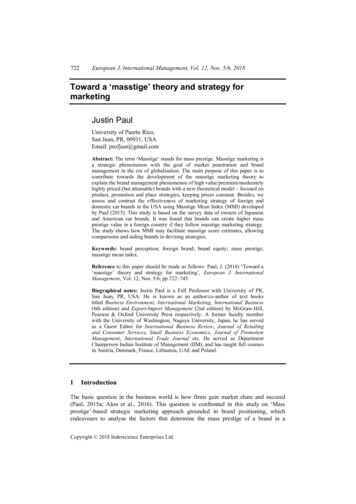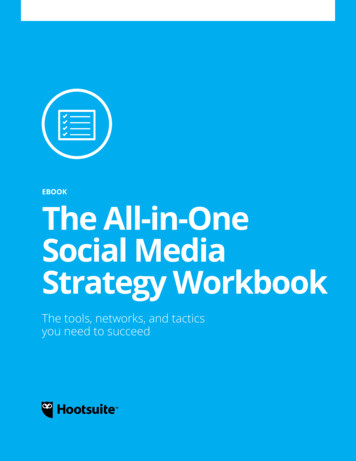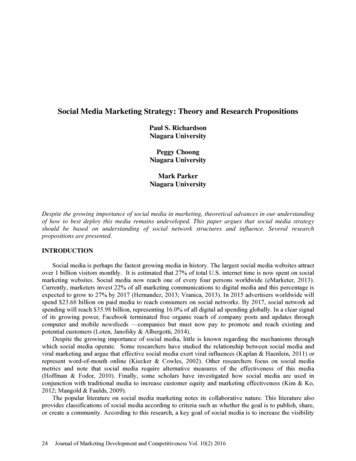
Transcription
Social Media Marketing Strategy: Theory and Research PropositionsPaul S. RichardsonNiagara UniversityPeggy ChoongNiagara UniversityMark ParkerNiagara UniversityDespite the growing importance of social media in marketing, theoretical advances in our understandingof how to best deploy this media remains undeveloped. This paper argues that social media strategyshould be based on understanding of social network structures and influence. Several researchpropositions are presented.INTRODUCTIONSocial media is perhaps the fastest growing media in history. The largest social media websites attractover 1 billion visitors monthly. It is estimated that 27% of total U.S. internet time is now spent on socialmarketing websites. Social media now reach one of every four persons worldwide (eMarketer, 2013).Currently, marketers invest 22% of all marketing communications to digital media and this percentage isexpected to grow to 27% by 2017 (Hernandez, 2013; Vranica, 2013). In 2015 advertisers worldwide willspend 23.68 billion on paid media to reach consumers on social networks. By 2017, social network adspending will reach 35.98 billion, representing 16.0% of all digital ad spending globally. In a clear signalof its growing power, Facebook terminated free organic reach of company posts and updates throughcomputer and mobile newsfeeds —companies but must now pay to promote and reach existing andpotential customers (Loten, Janofsky & Albergotti, 2014).Despite the growing importance of social media, little is known regarding the mechanisms throughwhich social media operate. Some researchers have studied the relationship between social media andviral marketing and argue that effective social media exert viral influences (Kaplan & Haenlein, 2011) orrepresent word-of-mouth online (Kiecker & Cowles, 2002). Other researchers focus on social mediametrics and note that social media require alternative measures of the effectiveness of this media(Hoffman & Fodor, 2010). Finally, some scholars have investigated how social media are used inconjunction with traditional media to increase customer equity and marketing effectiveness (Kim & Ko,2012; Mangold & Faulds, 2009).The popular literature on social media marketing notes its collaborative nature. This literature alsoprovides classifications of social media according to criteria such as whether the goal is to publish, share,or create a community. According to this research, a key goal of social media is to increase the visibility24Journal of Marketing Development and Competitiveness Vol. 10(2) 2016
of the firm online. To reach this goal, practitioners recommend that the firm dedicate significant time andresources to social media marketing activities in a systematic manner (Barker et al., 2013; Scott, 2009).Neither the academic nor the popular literature adequately explains the rise of social media. The factthat social media may be viral or collaborative cannot account for market capitalizations of firms in thissector, the hundreds of millions of user registrations, or the dramatic mergers between media giants.Indeed, Yadav and Pavlou (2014) lament that our understanding of the nature of consumer-to-consumerinteractions in social media is deficient. This lack of knowledge persists despite the fact that eWomelasticities advertising elasticities exceed by a significant margin (You, Vadakkepatt & Joshi, 2015).This paper argues that the effects of social media marketing can be understood from the perspectiveof social network theory. Several research propositions are provided based on this framework.SOCIAL NETWORK THEORYA social network is a specific kind of network where nodes are social entities (Van den Bulte &Wuyts, 2007). Nodes or entities are called actors. Actors are linked by social ties or relations. Social tieshave a number of properties including directionality, reciprocity, strength, and homophily. Directionalityrefers to the flow of direction between nodes. For example, a tie may flow from node A to node B. If a tieflows back from B to A, then ties are reciprocal. Tie strength refers to the intensity and tightness of a tiesuch as the amount of time, intimacy, or valence associated with the tie (e.g. the affective, supportive, orcooperative character of a tie). Ties are homophilic when actors interact with one another on the basis ofshared values or interests.Properties of social networks include transitivity, density, and closure. Networks high in transitivityare those for which ties stress reciprocity. Networks are said to be dense if a high proportion of actual topossible ties exists. Closure means the density among those in a network with whom an actor has a tie.Closure tends to increase with transitivity, which itself tends to be higher for ties with positive valence. Ifclosure among the neighbors of a focal actor is low, then this actor may represent a bridge and span astructural hole or gap in the network. (Van den Bulte & Wuyts, 2007).An actor’s importance in the overall network is measured by centrality. Degree centrality is thenumber of ties an actor has. This can be measured as out-degree versus in-degree. Closeness centrality ishow close an actor is to each of the other actors in the entire network such as the “degrees of separation”.Eigenvalue centrality measures the extent to which an actor with high prestige is connected to others withhigh prestige. Finally, centralization reflects the importance or prominence of the actors in the network. Acentralized structure means that the network is organized around focal actors (Van den Bulte & Wuyts,2007).Figure 1 shows an example of a simple social network of three actors. Ties are reciprocal. Actors areof equal importance as each actor shares the same number of in-degree and out-degree links. The networkis dense and closed. If the actors connect with one another on the basis of shared interests or mutuallyheld beliefs, the network is homophilic.Journal of Marketing Development and Competitiveness Vol. 10(2) 201625
FIGURE 1A CLOSED RECIPROCAL SOCIAL NETWORKSOCIAL NETWORK ANALYSIS AND SOCIAL MEDIAThe social network literature provides a useful framework to better understand social media. Actorsconsume social media through virtual nodes online. Social ties are created through links, sharing, ormemberships. These ties may be strong or weak, open or closed, directional or reciprocal. Some actorsmay enjoy centrality through a large number of in-degree links whereas others may not. The network maybe dense or distributed through a few focal actors.Figure 2 shows an example of an ideal online social network sponsored by the firm. In this case, thefirm forms a strong, bidirectional tie with each actor. This network is ideal because it simultaneouslycombines the many-to-many web communications model proposed by Hoffman and Novak (1996) withthe one-to-one web communications model advocated by Peppers and Rogers (1995). Hence, the firm hasthe opportunity to engage in value creation and co-production marketing opportunities efficiently andeffectively and foster brand communities (Anderson, 2005).FIGURE 2A MANY-TO-MANY, ONE-TO-ONE SOCIAL NETWORK26Journal of Marketing Development and Competitiveness Vol. 10(2) 2016
Social media differ in their ability to facilitate the creation of this ideal many-to-many, one-to-onesocial network online, which we will call the MMOO network. Table 1 classifies social media accordingto tie strength, network properties, and the communication model. The analysis shows that social mediathat stress social networks are best suited for the formation of MMOO networks. Hence, we propose thatsocial media marketing efforts should start by adopting and implementing those social media thatfacilitate the creation of a MMOO network platform and integrate these marketing efforts with corporatenetwork structures. Therefore, the following proposition is made:P1: The foundation of successful social media marketing is the creation of MMOO socialnetworks by leveraging social media that can create strong, bidirectional ties andrelationships and integrating the social media platform with corporate networks.TABLE 1KEY PROPERTIES OF SOCIAL MEDIATie StrengthNetworkPropertiesInformation BlogWeakFocal structureDiscussion,Q&A BoardsWeakFocal structureArticles/E-BooksWeakFocal structureWebinars, PodcastsWeakFocal structureMicroblogsModerateWeak balance andclosureFile SharingModerateWeak balance andclosureApps, LocationServicesStrongStrong balance andclosureSocial NetworksStrongStrong balance andclosureSocial Media TypeActor ImportanceDominant actor indegree linksDominant actor indegree linksDominant actor indegree linksDominant actor indegree linksDominant actorin-degree and outdegree linksDominant actor indegree and outdegree linksMany actors within-degree and outdegree linksMany actors within-degree and outdegree o-manyOne-to-manyOne-to-many, fewto-few, o-many,one-to-oneOther social media cannot easily replicate the ideal MMOO network. For example, Figure 3represents the social network structure of file sharing or a simple blog. Ties among actors are weak. Thenetwork is unbalanced, open, and has little density. The firm is the dominant actor as indicated by themost in-degree and out-degree links. The goal of this simple network is to encourage the consumption anddistribution of content. It is therefore similar to a one-to-many broadcast model but with viralcharacteristics. Hence, the following proposition is made:P2: File sharing media should be selected consistent with integrated marketingcommunication goals for one-to-many broadcast media.Journal of Marketing Development and Competitiveness Vol. 10(2) 201627
The premise of proposition 2 is that because file sharing media operate according to the broadcastmodel notwithstanding viral characteristics, content should be prepared and distributed according to thesame criteria as offline media. Petty and Caccioppo (1986) note that media possess central and peripheralcues according to involvement and that advertisements should incorporate both of these elements.Ratchford and Vaughn (1989) report that advertising strategies differ according to whether a productgenerates “think” or “feel” buying motives. This and related research provides detailed recommendationsconcerning advertising execution strategy. Therefore, file sharing social media for videos, images,articles, and e-books should likewise be used according to these strategies.FIGURE 3FILE SHARING NETWORK STRUCTUREFigure 4 shows the network structure of a microblog such as Twitter. Ties among the actors are weak.Actor importance is measure by in-degree links (“Follower”) and by out-degree links (“Following”) butprestige is associated with having a greater number of in-degree than out-degree links. Actors mayattempt to increase their own eigenvalue centrality or prestige by following the blogs of others toencourage a bidirectional link. The nature of this network depends upon its growth. A highly popularcelebrity blog will mimic the one-to-many model. Marketers may exploit this by implementing “celebrityblogs” for product sponsorship or endorsement. A more specialized blog based on a subject or productmay be targeted to fewer key customers and be characterized by a one-to-few model. Finally,personalized blogs based on individual needs may mimic the one-to-one model. Therefore, the followingproposition is made:P3: Firms should create multiple blogs and other forms of outbound communications tosatisfy one-to-many, one-to-few, and one-to-one marketing requirements accordingto relevant product or market segments, attitudes, interests, or opinions.28Journal of Marketing Development and Competitiveness Vol. 10(2) 2016
FIGURE 4NETWORK STRUCTURE OF A MICROBLOGFigure 5 represents the network structure of a discussion board or Q&A forum. This network consistsof two separate sub-networks which are bridged by focal actors. The network comprised of focal actors isbalanced, dense, and closed. These individuals have high eigenvalue centrality and this is often denotedwith badges and honorific certifications to demonstrate their role as moderators. These focal actorscoordinate service, communications, and requests from consumers of content who form a weak networkof ties. Although visitors may sometimes interact with other visitors, the moderators can terminateinteractions, delete, or modify content, close threads, or eliminate registrations.When focal actors play a responsible role, discussion forums can provide high quality informationand resolution to community problems and issues. It is therefore critical that moderators are perceived tobe credible experts to effect informational social influence. If the role of focal actors is weak, such mediawill degenerate and offer little value to visitors. This may also adversely impact the reputation of the firm.Therefore, the following proposition is made:P4: Firms that adopt discussion boards or fora should implement a focal structure ofadvocates.Journal of Marketing Development and Competitiveness Vol. 10(2) 201629
FIGURE 5NETWORK STRUCTURE OF A DISCUSSION BOARDFigure 6 augments the MMOO network to include social media vehicles to provide a more detailedoverview of social media marketing. The foundation of the MMOO social media network is provided bythe social network solutions platform provider (e.g. Facebook) in concert with the corporate network. Therelationship between the two entities may be so close that the corporate network accepts the userregistration data of the social network platform provider as valid credentials to access corporate assets.Social media vehicles including those that empower publishing (such as blogs, webinars, podcasts,articles, and e-books), file sharing (such as videos, photos, and websites), applications (such as online andmobile programs to connect with the firm), and geographic location services (such as maps or otherlocation sensitive programs or services) are then deployed by the firm (Barker et al., 2013). These socialmedia vehicles are strategically selected to maximize the value of the online social network. The strategicselection of social media vehicles can be called the social media mix. As is the case with the promotionmix, the social media mix is selected according to communication objectives and results are likewisemeasured according to forecasts and expectations.Hence, it is postulated that:P5: There exists an optimal social media mix which integrates investments across socialmedia vehicles and corporate networks to maximize impact and amplification.The equity derived from the MMOO network can be called social equity in contrast to customerequity. Customer equity is a measure of direct financial outcomes that result from first-time, repeat, andadd-on sales from the firm (Blattberg, Getz & Thomas, 2001). Social equity is derived from social capitalor the resources embedded within the network of relationships possessed by a person or social unit(Gonzalez, Claro & Palmatier, 2014). Social equity consists of both direct and indirect componentscalculated separately. Direct components of social equity accrue independent of network ties andinfluence. Indirect components of social equity accrue through network ties and influence.30Journal of Marketing Development and Competitiveness Vol. 10(2) 2016
FIGURE 6THE MMOO ONLINE SOCIAL NETWORKFigure 7 shows a hypothetical example of direct and indirect social equity effects. These are alsosummarized in Table 2. Direct links to the firm (“F”) indicate direct components of social equity value.The valence of links among actors indicates indirect components of social equity value. In this example,actor A has the greatest social equity value to the firm (3) because of strong indirect effects through otheractors despite no direct social equity value. Half of actor B’s social equity (2) derives from indirecteffects. All of actor C’s social equity value (1) derives from direct social equity effects.A firm that is unaware of social equity effects may miscalculate the true value of its customers. Forexample, from a customer equity perspective, actor A has a value of zero because of no direct contact.However, from a social equity perspective, actor A is the most valuable customer.Social advertising is a communications tactic designed to exploit social influence in social networks.Social advertising uses information about consumers’ peers, including peer affiliations with a brand,product, or organization to target ads and contextualize their display (Bakshy et al, 2014; Tucker, 2012a;2012b). For example, Facebook allows advertisers to communicate based on social connections ofexisting fans, and show ads that expressly indicate the name and likeness of targeted friends who like theadvertised object. Similarly, Google allows advertising to include social extensions in theiradvertisements. Hence, the ad represents an implied endorsement. Research indicates that socialadvertising can result in significantly greater engagement (Bakshy et al, 2014; Tucker, 2012a; 2012b).Journal of Marketing Development and Competitiveness Vol. 10(2) 201631
FIGURE 7THE MMOO SOCIAL EQUITY NETWORKTABLE 2SOCIAL AND CUSTOMER EQUITY OF ACTORSActor AActor BActor CTotalIndirect SocialEquity310Direct SocialEquity011Total SocialEquity3216Customer Equity0246A substantial literature on dimensions and determinants of interpersonal influence has been developedby marketing scholars (Bearden & Etzel, 1982; Grimm, Agrawal & Richardson, 1999; Park & Lessig,1977). Research suggests that whereas informational social influence is greater for cognitively motivatedpurchases, normative social influence is greater for affectively motivated purchases especially forconspicuous products (Grimm, Agrawal & Richardson, 1999). Therefore, it is proposed that:P5. Firms should utilize normative social advertising appeals for conspicuous productsthat elicit affective buying motives, and informational social advertising appeals forproducts that elicit cognitive buying motives.This proposition presumes that the social network structure is homophilic with strong mutual ties sothat social connections can be exploited. If the social network is characterized by a weak structure, thensocial advertising will not be effective. Instead, the firm should focus on promoting boundary spanningactivities to increase network strength and homophily.32Journal of Marketing Development and Competitiveness Vol. 10(2) 2016
P6. Firms should utilize electronic word-of-mouth and referral programs rather thansocial advertising when faced with a weak network structure.CONCLUSIONThis paper argues that social media marketing is more than the use of online collaborative media tocreate viral marketing or word-of-mouth effects. Social media marketing means strategically leveragingan optimal social media mix to satisfy communications objectives in support of the creation of a MMOOnetwork to maximize social equity. The foundation of this MMOO network rests on social mediaplatform solutions like Facebook that are carefully integrated with corporate networks. Shared logincredentials and social plugins are tools that can be used to foster this integration.A social network analysis of social media vehicles shows that most media termed social media maybe better called viral broadcast media because they do not have inherently strong social effects. Forexample, videos, photos, articles, e-books, and blogs may be easily shared but the distribution modelremains that of the one-to-many broadcast model from a social network perspective. The main actor is thepublisher whose goal is to increase the importance or visibility of the firm by generating in-degree links.Principles of broadcast media apply to creation and dissemination of this content. Well-understood andwell-tested theories related to advertising content and execution still apply. Therefore, it is not surprisingthat a popular use of YouTube is simply to post commercials distributed in regular broadcast channels.Analysis of some social media, however, shows important differences that require special attention.Social network analysis of microblogs such as Twitter indicates that a special form of centrality, namelyeigenvalue centrality can be at work. Prestige or expertise is associated with the number of “followers” orin-degree links relative to “following” or out-degree links. Marketers may exploit this by implementing“celebrity blogs” for product sponsorship or endorsement.Discussion boards and fora are often cited as examples of new collaborative social media. However,without careful design, such vehicles can degenerate into weak pools of communication because of thefree rider problem (Sohn, 2008). Therefore, strong focal actors are needed to monitor and discipline thenetwork structure to ensure success.For the firm to successfully create and sustain a MMOO network, direct and indirect contributions ofactors need to be measured and rewarded to maximize social equity. Social advertising may be well suitedas a communication tactic if homophily and multiple ties exist. However, the effectiveness of socialadvertising likely depends upon a variety of factors including buying motives, consumer involvement,product conspicuousness, and the availability of supporting expert or celebrity endorsements in theadvertising copy. If a social network suffers from low homophily and ties, social advertising will notwork. Instead, the marketer should emphasize referral and word-of-mouth programs.Social media marketing strategy will likely assume even greater importance given the rise of mobileplatforms and applications. Not only are mobile applications by social media giants like Facebook themost popular in terms of downloads (e.g. Facebook Mobile App, Facebook Messenger, WhatsApp,Pinterest, etc.), Facebook no longer provides free organic reach through newsfeeds. Instead, companiesbut must pay to promote and reach existing and potential customers (Loten, Janofsky & Albergotti, 2015).Therefore, marketers must stress even greater accountability in their social media marketing.REFERENCESBarker M.S., Baker D.I., Bormann, N.F., & Neher, K.E. (2013). Social media marketing: A strategicapproach. South-Western Cengage Learning.Andersen, P. H. (2005). Relationship marketing and brand involvement of professionals through webenhanced brand communities: the case of Coloplast. Industrial Marketing Management, 34(1),39-51.Journal of Marketing Development and Competitiveness Vol. 10(2) 201633
Bakshy, E., Eckles, D., Yan, R., & Rosenn, I. (2012). Social influence in social advertising: evidencefrom field experiments. Proceedings of the 13th ACM Conference on Electronic Commerce, 146161.Bearden, W. O., & Etzel, M. J. (1982). Reference group influence on product and brand purchasedecisions. Journal of Consumer Research, 183-194.Blattberg, R. C., Getz, G., & Thomas, J. S. (2001). Customer equity: building and managing relationshipsand valuable assets. Harvard Business Press.eMarketer. Social networking reaches nearly one in four around the world. June 18, rimm, P.E., Agrawal, J., and Richardson, P (1999). Product conspicuousness and buying motives asdeterminants of reference group influences. European Advances in Consumer Research, 97-103.Hernandez, N. The awesome growth of social media. May 15, of-social-media-2013-statistics/Hoffman, D. L., & Fodor, M. (2010). Can you measure the ROI of your social media marketing. MITSloan Management Review, 52(1), 41-49.Hoffman, D. L., & Novak, T. P. (1996). Marketing in hypermedia computer-mediated environments:conceptual foundations. The Journal of Marketing, 50-68.Kaplan, A. M., & Haenlein, M. (2011). Two hearts in three-quarter time: How to waltz the socialmedia/viral marketing dance. Business Horizons, 54(3), 253-263.Kiecker, P., & Cowles, D. (2002). Interpersonal communication and personal influence on the Internet: Aframework for examining online word-of-mouth. Journal of Euromarketing, 11(2), 71-88.Kim, A. J., & Ko, E. (2012). Do social media marketing activities enhance customer equity? An empiricalstudy of luxury fashion brand. Journal of Business Research, 65(10), 1480-1486.Loten, L., Janofsky, A., & Albergotti, R. New facebook rules to sting entrepreneurs. Wall Street Journal,November 27, 2014.Mangold, W. G., & Faulds, D.J. (2009). Social media: the new hybrid element of the promotion mix.Business Horizons, 62(4), 357-365.Park, C. W., & Lessig, V. P. (1977). Students and housewives: differences in susceptibility to referencegroup influence. Journal of Consumer Research, 102-110.Peppers, D., & Rogers, M. (1995). A new marketing paradigm: share of customer, not market share.Managing Service Quality, 5(3), 48-51.Petty, R. E., & Cacioppo, J. T. (1986). The elaboration likelihood model of persuasion. InCommunication and Persuasion (pp. 1-24). Springer New York.Rathford, B.T. & Vaughn, R. (1989). On the relationships between motives and purchase decisions: someempirical approaches. Advances in Consumer Research 1(6), 293-299.Scott, D. M. (2009). The new rules of marketing and PR: how to use social media, blogs, news releases,online video, and viral marketing to reach buyers directly. Wiley.com.Social Network Ad Spending to Hit 23.68 Billion Worldwide in 2015. eMarketer.com. April 15, 357Sohn, D. (2008). Social network structures and the internet. Amherst, NY: Cambria Press.Tucker, C. (2012a). Social Advertising. SRRN eLibrary. http://ssrn.com/paper 1975897.Tucker, C. (2012b). Social networks, personalized advertising, and privacy controls. Journal of MarketingResearch. Vol. 2, 546–562Van den Bulte, C., & Wuyts, S. (2007). Social networks and marketing. Marketing Science Institute.Vranica, S. & Bender, R. Advertising giants to merge: Omnicom and publicis aim to fight off growingcompetition from Silicon Valley. The Wall Street Journal, Monday July 29, 2013.34Journal of Marketing Development and Competitiveness Vol. 10(2) 2016
This paper argues that the effects of social media marketing can be understood from the perspective of social network theory. Several research propositions are provided based on this framework. SOCIAL NETWORK THEORY . A social network is a specific kind of network where nod

